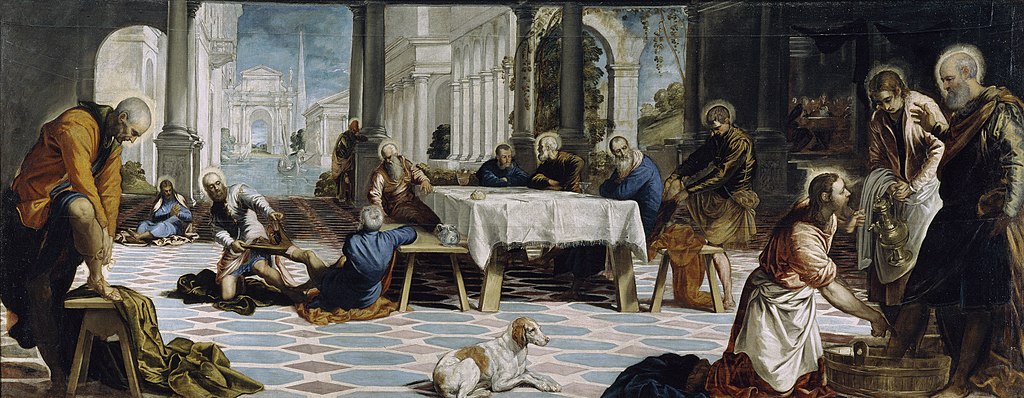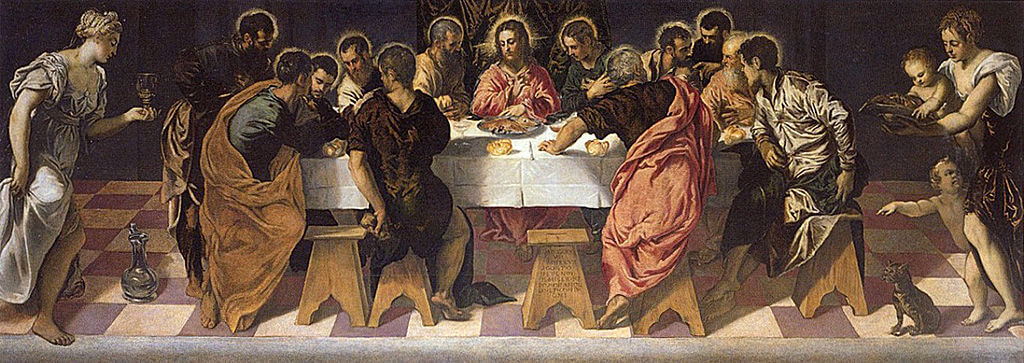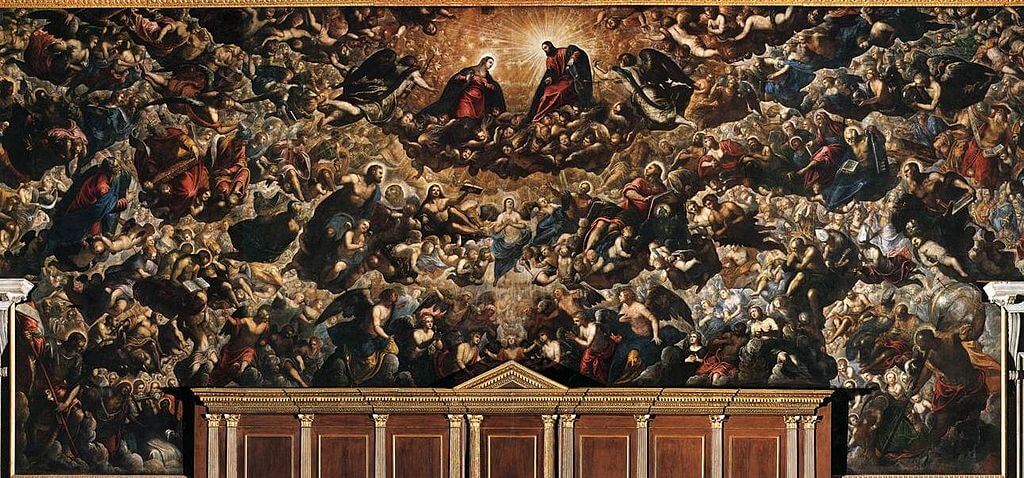|
Where? Room 25 of the Prado Museum
When? 1548-1549 Commissioned by? The Church of San Marcuola in Venice What do you see? On the right, Jesus sits on his knees and washes the feet of his disciple, Peter, who is reluctantly accepting that his master washes his feet. The young disciple, John, helps them by holding a watering can to fill the tub. In line with the Biblical story, Jesus has a towel wrapped around his waist. He has taken off his blue robe, which lies behind him. Scattered around the area are the other disciples. Four of them sit on the table. To the left of the table, one disciple comically helps another one to take of his pants. The disciple in the left foreground and the one to the right of table take off their sandals to have their feet washed. The disciple standing in the background against a pillar is Judas, who is about to betray Jesus after the Last Supper. Behind the head of Jesus, we can see another room with the follow-up scene. In that room are Jesus and his disciples celebrating the Last Supper. In the background, we can see some made-up architecture, based on 16th-century Venice. There is a canal with at the end a triumphal arch. Perspective: To fully appreciate this painting, one should look at it from the right side. So, stand to the right of the painting and you will see that the perspective suddenly is correct and that this is a beautiful piece of work. The composition starts with Jesus and Saint Peter, continues through the middle of the table, and ends at the arch at the end of the water. Notice how the tiles on the floor suddenly have a straight pattern. The reason that one should look at it from the right is that Tintoretto created this painting originally to hang on the right side of the apse (the area where the altar stand) in a Venetian church. Therefore, the churchgoers would automatically look at this painting from the right side. Backstory: This painting is also known as Christ Washing the Disciples' Feet. It is based on the Biblical story in John 13: 1-20, in which Jesus washes the feet of his disciples before they eat the Last Supper. Washing the feet was a common thing before having dinner as the people at that time wore sandals and walked on dusty roads. Typically, a servant washed the feet of the guests before dinner. Tintoretto created this painting for the Church of San Marcuola in Venice. On the left side of the apse hangs the Last Supper by Tintoretto and on the right side hung this painting on Christ washing the feet of the disciples. Today, it is replaced by a copy by Carlo Ridolfi (who also wrote a biography on Tintoretto). The original by Tintoretto entered the collection of the Prado Museum in 1936.
Other versions: Tintoretto loved the theme of Christ washing the feet of his disciples, and he created at least five different versions of it. Just like he did in the San Marcuola Church in Venice, Tintoretto often combined this painting with a painting on the Last Supper.
One version of Christ Washing the Feet of the Disciples hangs now in the National Gallery in London but was originally in the San Trovaso Church in Venice. Another version is in the San Moisé Church in Venice. Yet another version, very similar to the one in the Prado Museum, hangs in the Shipley Gallery of Art in Gateshead, England. It is not completely clear whether the original version in the Church of San Marcuola is the version in the Prado Museum or the Shipley Gallery of Art. A copy by Tintoretto of the Prado version hangs in the Ontario Gallery of Art in Toronto.
Moral: Jesus shows his humility by washing the feet of his disciples. As the leader of the disciples and the Son of God, he wanted to set an example that people are equal and that you are never better than another person.
Who is Tintoretto? Jacopo Comin, better known as Tintoretto, was born in 1518 in Venice and died there in 1594. He was a very talented painter. His aim was to combine the Mannerist drawing style of Michelangelo with the use of colors by Titian. This style is exactly what characterizes his work. Tintoretto was the oldest child and had twenty siblings. Tintoretto means ‘little dyer,’ and he was known by that name as his father was a dyer of clothes. Tintoretto was a very energetic and productive painter, and he created a large number of paintings often containing many figures. His masterpiece, Paradise, hangs in the Doge’s Palace in Venice. He started this painting when he was 70 years old, it includes over 500 figures, and measures about 25 x 9 meters.
Fun fact: The paintings contains a few interesting details. First, Judas is shown in the background. He has a halo around his head. This is strange as Judas is about to betray Jesus and halos are used to identify holy or sacred people. While Tintoretto is not the only artist to put a halo around the head of Judas, he is more commonly depicted without a halo, and sometimes with a black or darker-colored halo to separate him from the other disciples.
Another interesting detail is the dog in the foreground. It is not entirely clear why the dog is there. In any case, the presence of the dog caused Tintoretto some trouble. The inquisition thought that this was an unnecessary detail in this painting and this kind of detail was strongly discouraged for religious use by the Council of Trent earlier in the 16th century.
Written by Eelco Kappe
References:
0 Comments
Leave a Reply. |
Categories
All
|
- Home
- Blog
-
Museums
- Alte Pinakothek
- Art Institute of Chicago
- Baltimore Museum of Art
- Barber Institute of Fine Arts
- Bargello
- Barnes Foundation
- British Museum
- Church of Sant’Anastasia
- Cleveland Museum of Art
- Courtauld Institute of Art
- Detroit Institute of Arts
- Frans Hals Museum
- Galleria Borghese
- Gallerie dell'Accademia
- Getty Museum
- Guggenheim
- Hermitage Museum
- Kunsthistorisches Museum
- Kunstmuseum Basel
- Legion of Honor Museum
- Louvre
- Mauritshuis
- Metropolitan Museum of Art
- Musee d’Orsay
- Museum of Fine Arts in Boston
- Museum of Modern Art
- National Gallery in London
- National Gallery of Art
- National Museum in Poznań
- Norton Simon Museum
- Ny Carlsberg Glyptotek
- Palace of Versailles
- Palazzo Pitti
- Palazzo Vecchio
- Petit Palais
- Philadelphia Museum of Art
- Prado
- Pushkin Museum
- Ravenna Art Museum
- Rijksmuseum
- San Diego Museum of Art
- Santa Maria delle Grazie
- St. Peter's Basilica
- Städel Museum
- Statens Museum for Kunst
- Tate Britain
- Tate Modern
- Timken Museum of Art
- Uffizi
- Vatican Museums
- Wallace Collection
-
Artists
- Altdorfer
- Anguissola
- Berlin Painter
- Bosch
- Botticelli
- Boucher
- Bronzino
- Bruegel the Elder
- Brunelleschi
- Cabanel
- Caillebotte
- Canova
- Caravaggio
- Carpeaux
- Cezanne
- Cimabue
- David
- Degas
- Delacroix
- De Maria
- Donatello
- El Greco
- Fontana
- Fra Angelico
- Fragonard
- Gauguin
- Gentileschi
- Gericault
- Gonzalez-Torres
- Goya
- Hals
- Hogarth
- Hokusai
- Ingres
- Leonardo da Vinci
- Lippi, Filippo
- Longhi, Barbara
- Lorrain
- Makovsky
- Manet
- Massys
- Matisse
- Merian
- Michelangelo
- Mochi
- Modigliani
- Monet
- Panini
- Parmigianino
- Perugino
- Picasso
- Pisanello
- Raphael
- Rembrandt
- Renoir
- Reynolds
- Rivera
- Rodin
- Rubens
- Scultori
- Seurat
- Steen
- Tintoretto
- Titian
- Toulouse-Lautrec
- Turner
- Uccello
- Van der Weyden
- Van Dyck
- Van Eyck
- Van Gogh
- Van Hemessen
- Vasari
- Velazquez
- Vermeer
- Veronese
- Vigée Le Brun
-
Locations
- Books
- About Us




